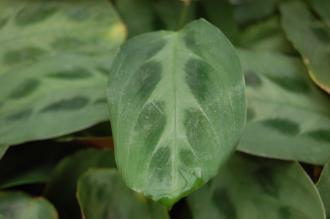
Maranta bicolor (28/02/2016, Kew Gardens, London)
Position: Indirect bright to low light
Flowering period: All year round
Soil: Moist, well drained
Eventual Height: 25cm
Eventual Spread: 40cm
Hardiness: 10b, 11, 12, 13
Family: Marantaceae
Maranta bicolor is an evergreen tropical perennial with a clump forming habit. Its dark green leaves have light green coloration around its veins, are ovate with entire margins, its underside is pale purple, are up to 15cm long and 10cm across. Its leaves tend to lay flat during the day and roll up into an erect position during the night. Its white tubular flowers are insignificant and appear on long stems.
Maranta bicolor, commonly known as Prayer Plant or Arrowroot, is native to east Brazil. In its native habitat it grows as a tropical woodland understory plant. Maranta bicolor is synonymous with Maranta cristata.
The etymological root of the binomial name Maranta is named after Bartolomea Maranti ( ? – 1571), a Venetian botanist. Bicolor is from the Latin meaning ‘of two colours’.
The landscape architect may find Maranta bicolor useful as an attractive foliage houseplant suitable for indirect bright and low light conditions.
Ecologically, Maranta bicolor is of little value in to UK wildlife.

Maranta bicolor Leaf (28/02/2016, Kew Gardens, London)
Maranta bicolor prefers moist, fertile, well-drained soils. It tolerates most pH of soil.
When maintaining Maranta bicolor as a houseplant its soil should be watered regularly. Watering should be reduced during the winter months. Its preferred active growing temperature rages from between 18ºc to 24ºc, it will tolerate a temperature as low as 15ºc. Feeding with weak fertiliser solution should be carried out every two weeks during the growing season. Regular spraying with water will help to improve the humidity for this plant. Red Spider Mite may attack this plant. Regular pruning of old growth will encourage a more attractive plant.

Landscape Architecture

